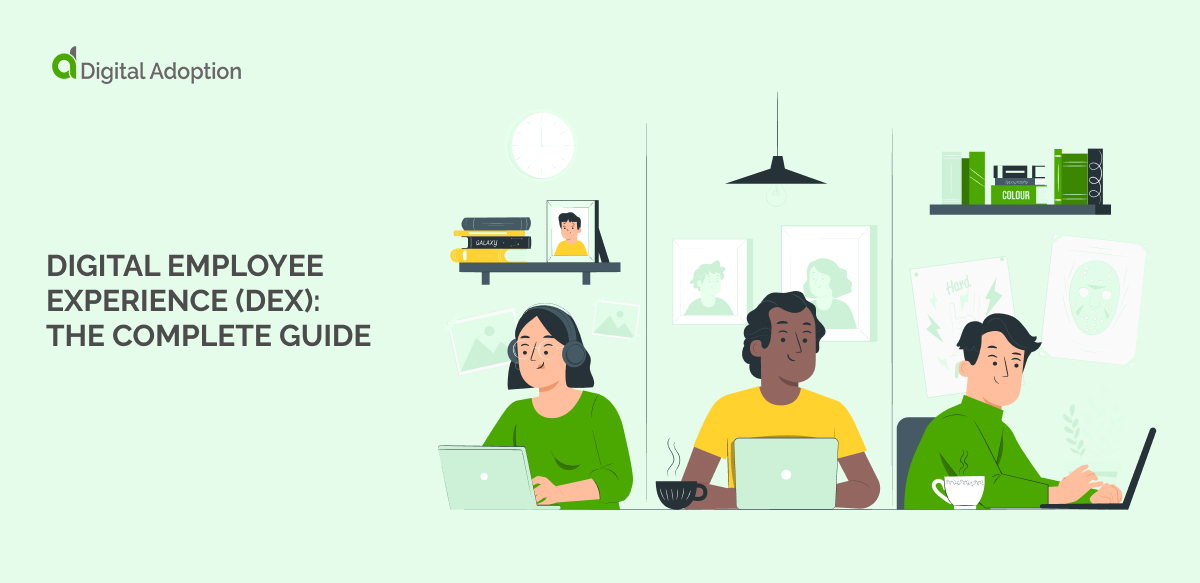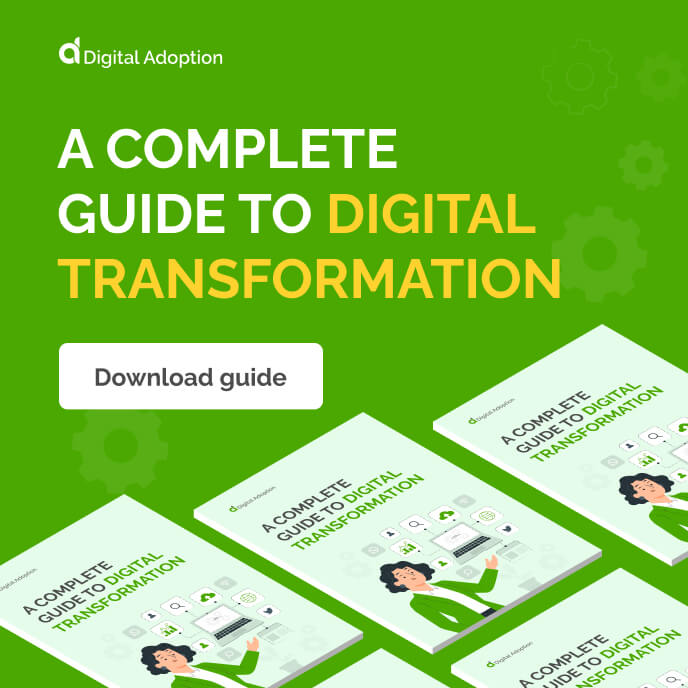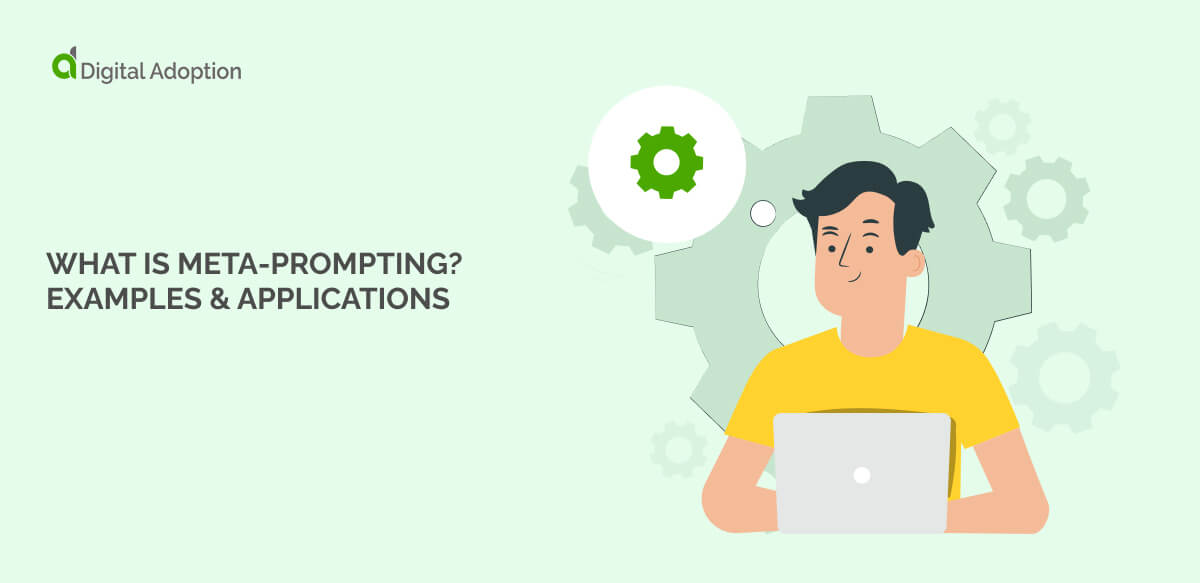Let’s be honest. Better digital employee experience (DEX) is something companies speak about a lot but don’t always feel able to optimize for their staff. DEX can be an awkward combination of investment into digital innovation and employee experience. Issues such as employee resistance and change management add to the obstacles behind the best practices to empower employees.
Digital transformation and DEX are the new buzzwords in today’s corporate world. With technology becoming increasingly advanced, it is no surprise that companies have had to adjust and adapt their processes. And with digital adoption on the rise, companies must ensure that their employees are well-equipped to use the new digital tools and technologies.
Although this is a challenging journey, you are in good hands as we present the complete guide to giving your employees the best digital experience that will lead to successful digital adoption and a complete ROI.
This guide covers the digital employee experience, why it is essential, and challenges, benefits, and examples.
- What is Digital Employee Experience?
- Why Is The Digital Employee Experience Important?
- Digital Employee Experience Examples
- Digital Employee Experience Benefits
- Digital Employee Experience Challenges
- The Digital Employee Experience And The Future of Work in 2023
- Listen To Your Employees For Successful Digital Employee Experience
What is Digital Employee Experience?
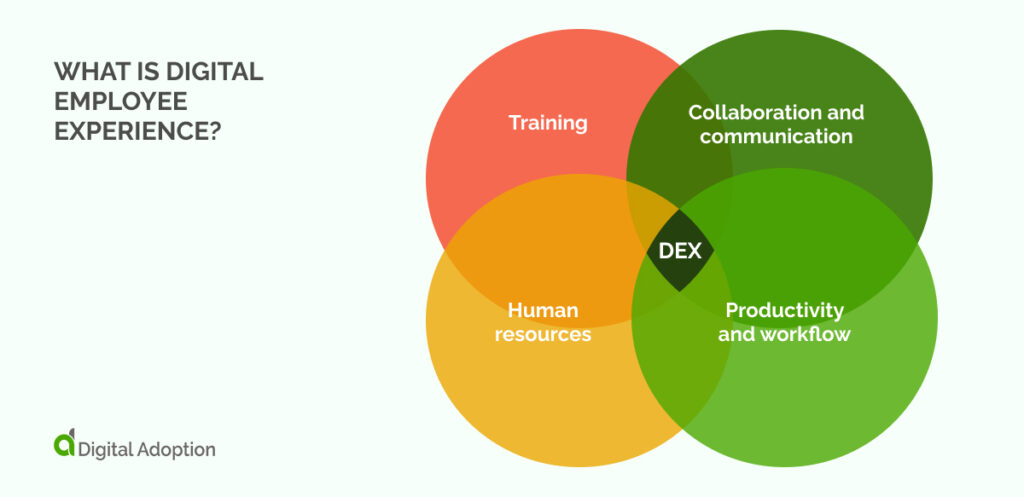
Digital employee experience (DEX) is how your employees interact with and feel about technology. Successful DEX involves listening to employees’ needs and ensuring the organization meets them by considering various learning styles and letting employees know how good DEX benefits them.
DEX affects many aspects of business, such as:
- Training: Ongoing training and professional development systems are invaluable for DEX.
- Collaboration and communication: Asynchronous communication tools such as email, instant messaging, phone calls, and video conferencing are all examples of invaluable resources for successful collaborations.
- Productivity and workflow: Tools that employees use to achieve success in their work, such as project management, analytics, customer service, finance, and marketing, are key components of successful DEX.
- Human resources: Leveraging talent management systems makes it easier to access various HR-related information, such as compensation and benefits, PTO resources, performance reviews and objectives, wellness activities, and company regulations. HR departments unlock DEX potential through self-service portals allowing them to access their accounts on the go.
It is essential to consider how you implement DEX throughout these aspects of your business to achieve success.
Now we have defined DEX, let’s explore why digital employee experiences are important.
Why Is The Digital Employee Experience Important?
The increasing market demand for constant technological change leads some companies to rush digital innovation, but the digital employee experience is at the heart of any successful company. With practical digital employee experience, staff feels listened to and understand their role in making their organization prosperous and incentivized to do so.
The impact of DEX grows more indispensable annually in providing an outstanding employee journey. It influences every stage of the employee life cycle, from recruitment to onboarding, improving performance, and even affecting whether staff returns to an organization after they depart. From their first day at their new company, the digital experience is always present – influencing each step and customer experience management.
Now we understand why DEX is essential, let’s see it in practice with a few examples.
Digital Employee Experience Examples
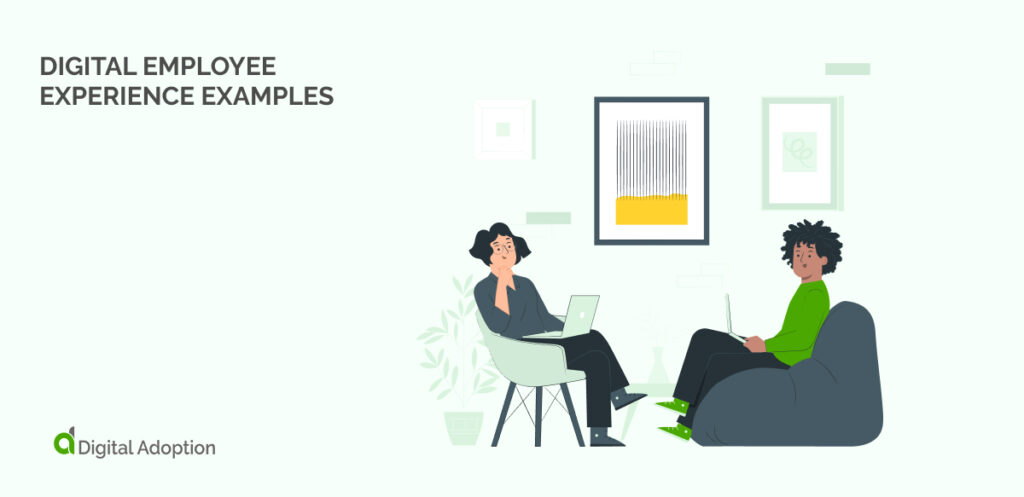
Let’s look at some examples of DEX supporting staff to allow your organization to recognize signs of effective DEX practice.
Effective DEX impacts positively all parties that interact with it, whether this is potential candidates or existing employees. As a result, DEX impacts onboarding, training, and operations. Some examples include:
- Onboarding: Adaptive AI can automate data entry, allowing HR staff to focus on higher-level tasks and hide certain personal information from recruiters to allow blind candidate selection based on experience and skill, reducing bias and improving DEX.
- Training: A DAP (digital adoption platform) can support personalized features for hybrid, remote, or on-premises staff, such as several languages and other features, allowing staff to learn new technologies in a way that suits them.
- Operations: IT teams’ operations can use metrics to measure staff performance. It is helpful that this tool is used as a supportive tool and that staff is informed when they are achieving expectations and when they are not.
These examples of DEX can help you identify success and strive toward it, which comes with many benefits.
Digital Employee Experience Benefits

When you achieve a digital employee experience, you will enjoy many benefits, ranging from employee well-being and resulting higher employee retention rates to a healthy, positive culture of innovation and growth.
Retention
When staff can fulfill their role, employee engagement is higher, and they are less likely to consider departing the company. This consideration is essential when Gartner predicted that, based on previous years, 37.4 million US employees would quit in 2022, underpinning the importance of DEX in being part of a multi-faceted approach to retain the investment into staff.
Recruitment, onboarding, and training costs are high, with Statista showing the annual US training expenditure to be 101.6bn USD in 2022. Retention contributes a huge amount of value to reducing company waste and maintaining time and monetary investment in building company culture.
Wellbeing
The philosophy behind caring for staff is that if the organization cares for them, they will care for the organization. Statista shows how important well-being is to staff flexibility, as in 2021, 79% of US employees said that the balance between work and personal life was one of their main concerns, an increase of 2% from the previous year.
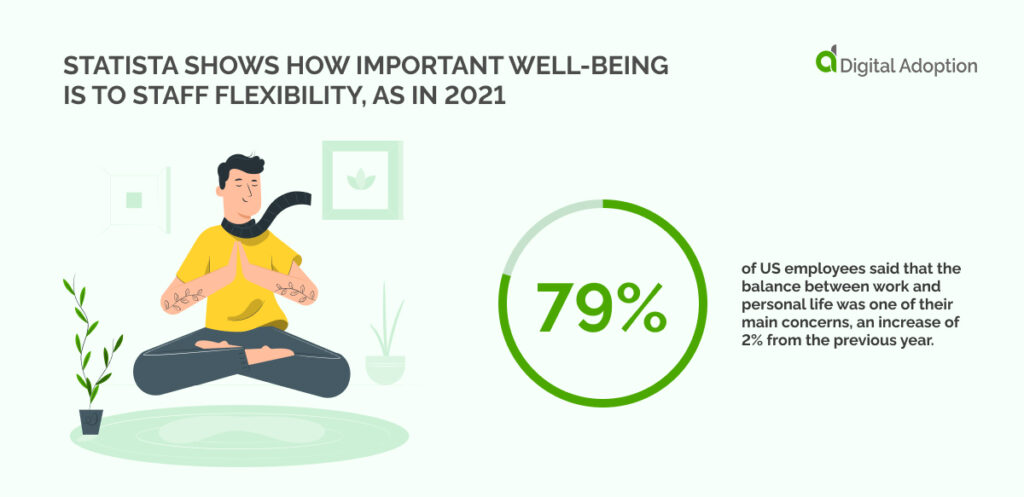
This statistic shows that these needs may not have been met, and employee concerns for lack of flexibility were growing. Meeting these needs with great digital employee experience helps you acquire and retain top talent.
Culture
The critical aspects of your company culture are promoting communication, learning, and a readiness for change to create the best DEX for staff. A strong organizational culture can also help direct staff resources toward implementing changes, reducing resistance to change via an improved DEX.
Now that we have looked at the benefits of digital employee experience, let’s look at the challenges.
Digital Employee Experience Challenges
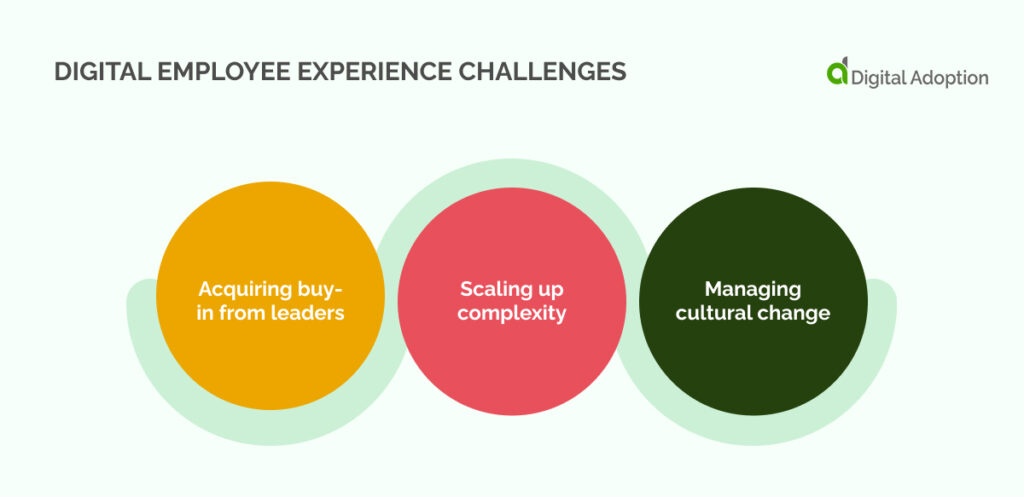
The challenges for DEX often come in the form of a digital transformation that requires staff to learn new technologies. The complexity of this scenario is that people are hesitant to engage with change and often depart their companies due to burnout.
To avoid departures, focus on overcoming these challenges, such as:
- Acquiring buy-in from leaders.
- Scaling up complexity.
- Managing cultural change.
Let’s look at each of these in detail.
Acquiring Buy-In From Leaders
Organizations often invest heavily in solutions that don’t deliver results. Even if their internal digital tools compete with external-facing projects for funds, implementing new technology is still expensive.
To secure financial backing for certain upgrades, demonstrate the tangible link between these systems and successful outcomes. Highlight the importance of engaging with employees and keeping them on board to maximize your return on investment.
Scaling Up Complexity
As your business grows and evolves, so will the digital tools it needs to operate. This point could depend on many aspects, such as size, industry, or customer expectations. To ensure that you invest in compatible technologies for your team members, involve IT leaders from the beginning of the process. With their help, various digital tools can be available for employees to use efficiently when completing tasks.
Managing cultural change
In order for organizations to deliver an exceptional digital employee experience, a collaborative effort between IT teams, HR, facilities, and other departments is essential. Collaboration will be hindered if there are numerous disconnected silos within the organization, which can negatively impact company culture.
When considering the challenges of DEX, it’s essential to be aware that the most efficient way to overcome employee experience challenges is to convince staff of the benefits to each individual by providing the best DEX.
Now we have looked at the challenges of DEX,let’s see what the future holds.
The Digital Employee Experience And The Future of Work in 2023
While it is essential to consider every aspect of DEX for the present day, it is also essential to consider actions and investments for the future to retain your top talent by providing them with the best digital employee experience. The core of this approach is trust.
Trust cuts to the heart of what gives DEX its value, representing the relationship between employer and employee. Because, in reality, DEX has little to do with technology and is mostly concerned with people: your staff. The first way to build this trust in 2023 and beyond is by using the three Cs of trust: culture, care, and communication.
Culture
Many companies know the importance of building a positive culture, but trust should always be at the heart of every company culture. With a trusting culture, the other Cs of trust, communication, and care come without much effort. Trust builds a strong foundation for the positive elements of a culture that provides for individuals and their organizations.
Action points:
-Be transparent and honest with mistakes and failed digital initiatives.
-Regularly publish corporate earnings.
Care
People will likely trust you when they feel the relationship is mutually beneficial. Show genuine interest in others by recalling specific details, such as a colleague’s child’s name, or inquiring about their weekend plans. This small gesture goes a long way!
Have you ever interacted with someone who seemed to be in their world and never paid attention to anyone else? On the contrary, have you also encountered individuals who were always friendly and maintained a genuine interest in your well-being? Who did you find more reliable out of these two types of people?
Action points:
-Offer leadership staff soft skills and mental health first aid training so staff feels cared for and less likely to depart.
Communication
Miscommunication can quickly and easily erode trust, so communicate in a way that leaves no room for confusion. Listening is just as essential as speaking when it comes to effective communication; show your respect by giving the other person time to talk and pay attention. It will prove that you are invested in what they have to say if you listen carefully.
Action points:
-Ensure leaders communicate in a meaningful way for every employee.
-Offer employees different ways to offer feedback.
Listen To Your Employees For Successful Digital Employee Experience
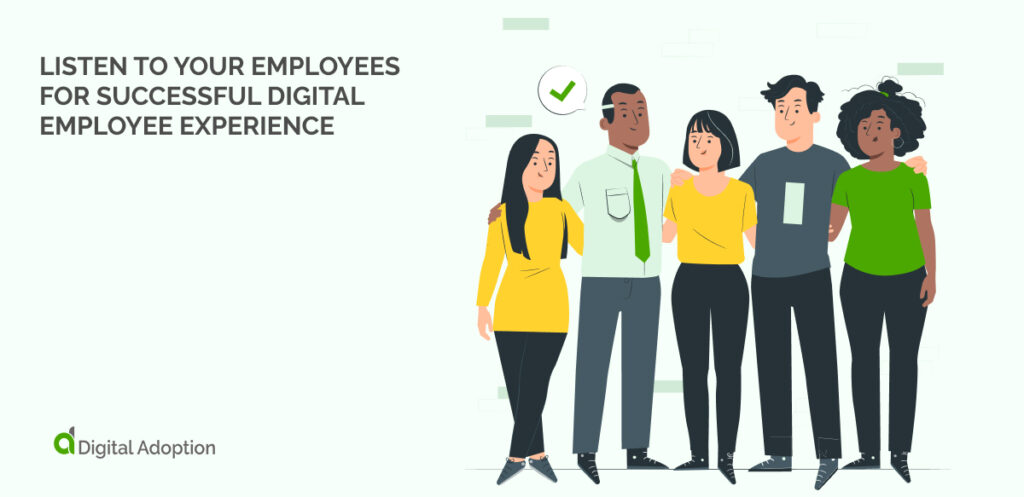
It is important to remember the value of investing in creating a positive and productive work environment for your employees. Without their engagement and motivation, no amount of planning or strategy will lead to successful digital workplace initiatives.
However, every organization’s DEX journey is unique. By listening to your employees’ feedback, making thoughtful changes, and addressing their needs, you can build a practical solution that helps optimize productivity and satisfaction among everyone involved as you achieve complete employee satisfaction using workplace technology.
Take the first step to implementing a successful DEX strategy today: ask your employees what they need at their fingertips to succeed! With these insights, you can create a unique digital employee experience that encourages workplace collaboration, synergy, and innovation.

